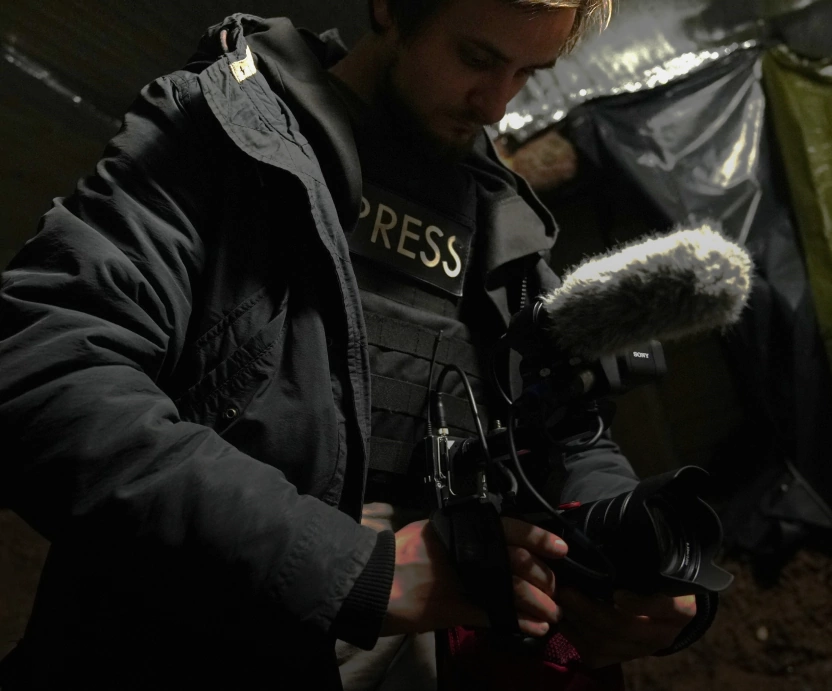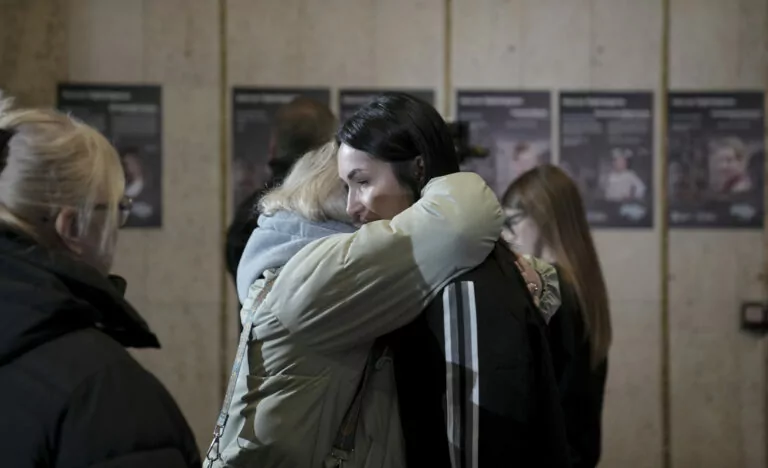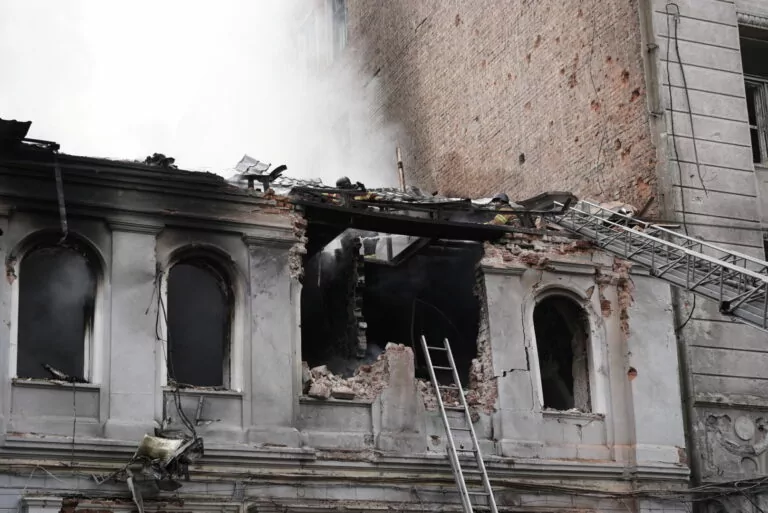Last year, a thing that happened in my neighbourhood happens again and again in other cities. The green area near the child care center, which my children visited, was illegally turned into an addition to the construction site of the ATB supermarket. It was a wasteland overgrown with perennial grasses and mature self-seeding trees and located near the exit metro station and on the way home for the main flow of people in the neighborhood. Not the distance from people made this place a wasteland, but only clutter and neglect. Due to the ongoing construction, all the vegetation was cut down on the site, the grass cover was destroyed, special equipment was driven back and forth on the open ground, cement was mixed on it and construction materials were unloaded. It was the beginning of summer, and I was stressed by the thought of the inevitable influx of dust on the territory of our child care center. The area was obviously used illegally, because, as the Public Cadastral Map of Ukraine testified, it was not allocated for construction or anything else.
Then a dream was born in my heart: if only to turn this once abandoned and now desecrated green area into a demonstration area of urban meadow weeds, just as it is now practiced in Germany. Such areas require almost no mowing and watering, and they are very effective as a green filter and humidifier, providing home and food for insects, which are food for urban birds. Looking at the bare red earth mixed with rubble, plastic and brick, I was seeing a life-filled educational playground for children and a quiet recreation area for adults in it.
At first, I organized a small initiative group of four people, which submitted an appeal to the city mayor (such great were our ideas about the addressee to whom we decided to assign this case!). We demanded the restoration of the soil and the granting of the status of a green zone to this territory, so that the locals could then green it on their own. Trying to somehow protect the future clearing from clogging, we separately asked NOT to put benches that would entice those “willing ones” to leave garbage. Of course, we supported our demands with signatures: 23 residents of the neighborhood supported this appeal (in fact, no one refused us, and we just decided that the pages of live signatures will be enough). I admit: the wording of the requirements of our paper was a bit naive, and the desired result in the form of meadow grasses is not described at all. At that time, I was extremely lacking in information on how to manage the green areas of our city, and therefore, an understanding of to whom to turn and what to ask.
Looking at the bare red earth mixed with rubble, plastic and brick, I was seeing a life-filled educational playground for children and a quiet recreation area for adults in it.
Therefore in a month, we received an answer from the Shevchenkivskyi district administration, as well as an identical answer from Zhilkomservice, the content of which had little to do with the request. I thought that we demanded to restore the damaged soils and consider the possibility of arranging a green zone with the involvement of residents in its landscaping. However, we were told that “the specified territory is not on the balance of UPC Kharkivzelenbud.” In addition, they listed the possible uses of the site according to the zoning plan of Kharkiv city, among which was the option of “green area”. So, our area can be a green zone, but it is not. It is almost the same what we have before the appeal. But we did not receive clear information about the plan to do something in the direction we voiced.
Reading this answer today, I understand it much better. The scheme of management of city plantings in Kharkiv collected on crumbs from open sources helps to “translate” the words of officials. However, they answered not quite in essence but it still gave us some guidance. But to understand the instructions, one should know what is laying behind the concepts of “on the balance of UPC “Kharkivzelenbud “, why this organization is mentioned and so on.
So, what happened to the dreamt land? To our surprise, in November or December, six months after the appeal, 7 apricots were planted here (according to eyewitnesses, a deep hole could not be dug, so seedlings in the compacted soil were planted and sprinkled the ground from above). In addition, 5 benches were dug in the “clear field” without any arrangement of passages, platforms, not to mention the installation of landfills (placed next to two supermarkets and a neighbourhood market). Who could be the organizer of such a “charity”? Afterwards, my neighbours shared their assumptions with me. They said that such way of working is the traditional Kharkiv way of fulfilling the residents’ demands: the city authorities make an unofficial demand to commercial organizations along with the “scene” to fulfill the so-called landscaping works. Probably, in this case, they turned to the newly built supermarket “ATB”. This spring showed that only one seedling survived. Now the land is not cleaned, it is self-seeded with weeds, some meadow grasses (which, by the way, bloomed very nicely in summer, despite the fact that no one watered them) and two pseudoacacia Robinia trees. In mid-summer, the natural vegetation was probably cut down by “benefactors” as well. Moreover, small developers are “mastering” the site without proper land rights.
Last year I was confused. However, now I think that such acts of public initiative need to be prepared more meticulously. I am currently proposing my version of how several utilities and departments of the Kharkiv City Council are connected by landscaping. Yes, it is only the version so far. After all, there is no such detailed information in free access, and it is extremely difficult to obtain it in full from the representatives of these organizations (although we continue to discover it).
While waiting for an answer from the City Council on the request for the distribution of responsibilities for the maintenance of greenery, I carefully searched for information in open sources, which included the website of the Kharkiv City Council, the sites of utilities that have them, web portals of open data of the Kharkiv City Council, the tenders of Prozzoro portal, as well the Kharkiv Environmental Protection Program for 2013–2020. The answer from the City Council came on time and in general outlines confirmed a part of my version, and also provided information on one unexpected organization.
Important theory
Current legislation considers trees and other greenery in the city as elements of landscaping. From this point of view, trees in the city are commensurate with benches, lanterns, park paths or fountains. This means that the focus is shifted to the “balance” of human convenience: there should be not only a tree, but also a parking lot next to it and a bench under it, then the balance is considered achieved. Of course, if we were talking from the ecological view, then neither the parking lot nor the bench in the urban environment would be considered such equivalent elements of greenery.
There are a number of legal restrictions on growing trees in the city, restrictions concerning the very possibility of an existing tree. Again, the reason is that the legislative documents relating to trees in the city are not part of environmental legislation, but urban planning. The protection of green plantations in them is mentioned in general terms, the legislator regulates mostly the use of plants by humans, which means the use with very little regard for the role of plants in urban ecosystems and microclimates.
Landscaping is not only the planting of greenery but also their removal (what an oxymoron!). This term also covers mowing the grass, removing fallen leaves, watering, fertilizing, treating and protecting against pests, and so on. When we talk about “repair of green facilities”, it can mean both planting trees and painting street furniture in the park (see paragraph 13.1.1. of the Rules for the maintenance of greenery in the settlements of Ukraine). Therefore, the general term “landscaping work” always requires clarification of how one defines in the specific case, if it is even at stake.
Trees and other greenery in Kharkiv are directly taken care of by two departments of the City Council:
– The Department of Public Utilities deals with public areas (e.g. parks, squares, boulevards) and, apparently, with special-purpose areas such as driveways and roadside plantations;
– The Department of Housing takes care of adjacent areas, which are called areas of limited use, as well as areas of homestead development (“private sector”).
All other territories should be taken care of by their owners or balance holders (for example, the territories of private enterprises, schools or hospitals). These departments have several utilities that can carry out landscaping work. The departments themselves do not do the work directly, but planning is not their sole prerogative (to find out this aspect remains a matter for the future).
Specialized and non-specialized enterprises
Kharkivzelenbud Specialized Municipal Enterprise (Department of Public Utilities) maintains 203 nature protection facilities, including our forest park, all city squares, and those parks that do not have the name “culture and recreation” in the name, 2 hydro parks and 2 meadow parks. Kharkivzelenbud plans and arranges kilometers of flower beds and hectares of lawns. It includes a large flower greenhouse. This is the only company that not only demolishes trees (2123 pieces in 2019), but also plants them (805 pieces in 2019).
Kharkivzelebud will almost ultimately win tenders for the care of green areas, which are arranged by the Department of Public Utilities (in 2020, a tender was almost 81 million UAH). This company is meant when the city council reports on the achievements of Kharkiv’s gardeners, in particular, it is the protagonist of all the news on this topic on the website of the Kharkiv City Council.
According to the certificate from the City Council, Municipal Enterprise (ME) “Association of Culture and Recreation Parks of Kharkiv” (Department of Public Utilities) is also a specialized enterprise. It is responsible for those parks of the city that have an appendix in the name “culture and recreation”. However, the Central Park of Culture and Recreation named after Gorky does not subordinate to it. Instead, it has its own ME, subordinated to the Department of Culture (the mentioned certificate from the City Council does not say about this ME at all, but it exists).
The Department of Housing instructs to work with greenery on the adjacent territories of ME Zhylkomservice. The latter involves already LLC Progressive Cleaning Systems (for Slobidsky and Kholodnohirsky districts) and ME Kharkivblagoustriy (for other districts of the city), concluding agreements with them. Accordingly, these organizations manage within the limits of the means allocated under agreements with ME Zhilkomservice. That’s what the reference from the City Council tells us.
It is a question of territories at “houses of municipal property”. It’s how the Kharkiv City Council calls all the residential buildings in the city where there are no condominiums or housing and communal services, even if all the apartments in them are privatized, i.e. they are private property. By law, everything should not be decided automatically, as all apartment owners are recognized by the well-known “Law on high-rise buildings” as co-owners of common property for the house and must determine the owner of their trees or simply do the work themselves. However, Kharkiv residents are not active in their management rights, so the city council is doing the same thing. These enterprises are involved in mowing the grass, raking and removing fallen leaves, demolition and crowning of trees in residential areas.
ME Kharkivblagoustriy has in its structure separate landscaping sections and separate sections of another type, which are mostly located at the same addresses as the sections of Zhilkomservice. When the website of the City Council mentions the work of this enterprise in its news, it is referring to the achievements of “communal services” – probably to separate them from “gardeners” of Kharkivzelenbud.
Although ME is supposed to work with adjacent territories, its employees can also be seen cleaning the central streets, which are actually maintained by Specialized utility company Kharkivzelenbud. For unknown reasons, Kharkivblagoustriy does not participate in profitable and expensive tenders of its department (compare it with Kharkiv Repair and Construction ME).
ME Kharkivblagoustriy (Department of Housing) has in its structure landscaping (as we learn from random news on the website of the City Council) and is involved in mowing, raking and removal of fallen leaves, demolition and crowning of trees in adjacent areas or areas served be ME Zhilkomservice. The division of powers with Zhilkomservice is not publicly covered. Although the KP has to work with adjacent areas, its employees can be seen cleaning the central streets. For unknown reasons, Kharkivblagoustriy does not participate in profitable and expensive tenders of its department (compare it with Kharkiv Repair and Construction ME).
ME Blagoustriy of Kharkiv (Department of Housing) is not listed on the website of the City Council. As for green areas, this company offers the same services as ME Kharkivblagoustriy and Kharkiv Repair and Construction ME but declares the focus on homestead development (“private sector”). This orientation is confirmed by the certificate of the City Council.
This company includes the Inspection Service, which, in particular, is authorized to monitor the preservation of landscaping elements (and now we know that it is also referred to trees) and even “prepares proposals for lawsuits for damages to landscaping facilities due to violations legislation on the improvement of settlements”, as indicated on the company’s website.
Kharkiv Repair and Construction ME (Department of Housing) has the same functions as ME Kharkivblagoustriy according to the statute. During 2018–2019 yy., this enterprise consistently won multimillion-dollar tenders of the native department for demolition and crowning of trees in the adjacent territories of Kharkiv (during 2018–2019 yy., the total was almost 22 million 800 thousand UAH). However, in 2020, its documents were rejected in a tender for almost 10 million, and the tender itself did not take place.
ME Zhilkomservice (Department of Housing) plays the role of balance holder of greenery in residential areas in the management of greenery. Therefore, this ME concludes agreements for their maintenance, as well as accepts applications for inspection of trees from city residents. Its representatives must take part in the following survey: this is required by the Rules for the maintenance of green areas in populated areas, although it does not specify what exactly depends on the employees of Zhilkomservice (balance holder) and what knowledge they should have. One of the obligatory signatures on the act of inspection of plantations is theirs.
ME Association of Parks of Culture and Recreation of the City of Kharkiv (Department of Public Utilities) maintains and deals with the improvement of parks, which have an appendix in the name of “culture and recreation”. However, this does not include the Gorky Park, which has its own ME and is subordinated to the Department of Culture.
The level of the city landscaping is also significantly influenced by the Departments of Urban Planning and Architecture and the Department of Land Relations, allocating land for development and changing the ratio of landscaped and built-up areas of Kharkiv.
Control over controllers
In addition to the enterprises-executors, in the composition of the departments of the City Council, there is a whole bundle of other controlling authorities. The Department of Public Utilities has the Department of Ecology and Landscaping, which in turn has the Inspectorate for Landscaping and Ecology of Kharkiv. The Department of Housing does not have a separate institution for landscaping control (or, perhaps, we simply do not know about it), but one of its enterprises (ME Blagoustriy of Kharkiv) has an Inspection Service in its structure.
Considering the organizational structure of the Kharkiv City Council (check it out if you succeed), we see the two entire control departments. One, which is called the Department of Control, has, among other things, the Department of control over the improvement of the city. The second, called the Department of Territorial Control, also recently, on August 19, 2020, established the Improvement Inspectorate with an expected staff of 100 people.
Besides, there is a specialized supervisory state body, the State Ecological Inspectorate in Kharkiv region. It must prevent violations as well as bring the perpetrators to justice. However, active citizens cannot involve the State Coinspection in these actions…
How are landscaping utilities presented on the Internet?
Now we know how the Kharkiv landscaping services and even their control bodies are organized. Does it benefit us? Personally, I see new institutions of the city control over improvement and in case of need, I know that I will contact them. However, will this knowledge help organizations in initiating new landscaping and new green fund practices for the community? Apparently, the implementation of public projects in the field of landscaping in Kharkiv does not begin with city services contacts. Of course, it is necessary to communicate with them, but there is no need to rely on their good will to do even what they verbally agree with. Why so?
Because to a large extent, the current style of keeping greenery in Kharkiv is supported by a significant part of ordinary citizens. The frequency of mowing the grass, especially at the very root, demolition of unwanted trees “on request”, growing lawns under trees in the park, and laying expensive but environmentally friendly flower beds – all of this is a request and blessing from some Kharkiv residents… Although such practices do not adapt the city to climate change, do not preserve or restore urban soils, and do not save any water.
In Canada and European countries, when the demand of citizens and the perception of city services about some need do differ, the mayor’s office conducts explanatory work that suggests information campaigns. In our city, the city landscaping services only shield themselves from criticism for outdated care practices by nodding at “residents’ requests” and saying “decide it in your own yard.” There is no educational work on their part. So I want to ask why the services please only certain desires of certain Kharkiv residents, and not, to say, the advice of the Other Way (NGO Second Way).
So after a year of observing the area, which I dreamed of turning into something special, I realized that I need to start with direct action: put a tent on this area, draw an infographic of the desired and talk to neighbours on a constant basis, residents of the neighborhood. I need to seek support, ponder doubts together, overcome despair (expressed by “it’s not for our people”, “everything will be littered and broken”). And I recently learned that this is how the transformation of public space in Eastern Europe actually took place.




